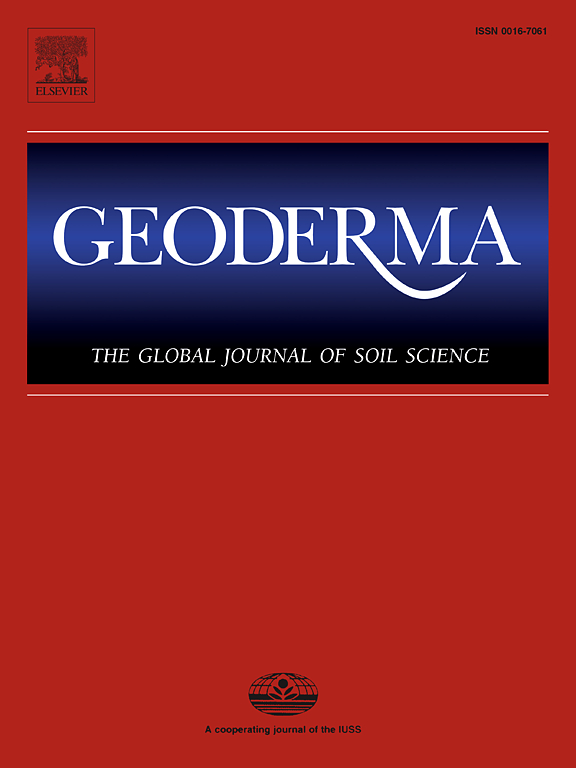钼通过大豆关键黄酮类化合物(Glycine max)调控磷循环物种多样性,提高土壤磷有效性
IF 5.6
1区 农林科学
Q1 SOIL SCIENCE
引用次数: 0
摘要
施用钼肥可以提高土壤磷的生物有效性,减少农业对磷肥的需求,促进作物生长。然而,这些好处背后的确切机制尚不完全清楚。我们首次展示了钼对大豆根际磷形态、代谢物和微生物转化的影响。在控制条件下进行了一系列盆栽试验,施用不同水平的钼,并在不同处理下采集大豆根际样品,全面分析了磷的形态、代谢特征和微生物群落。钼通过促进铝结合磷(Al-P)和有机磷向速效磷的转化,促进了大豆对磷的吸收和生长,其机制可能与钼对土壤代谢产物丰度的调节作用有关,从而重塑了根际微生物群落结构。钼介导的黄酮类化合物chrysin (Cs)和phlorizin (Pz)显著促进大豆生长和磷的吸收。随后,土壤宏基因组学和磷溶菌(PSB)添加实验证实,这些黄酮类化合物增加了磷循环基因(如gcd和phoD)和微生物,促进了稳定磷向不稳定磷的转化,并帮助枯草芽孢杆菌(PSB)进一步提高土壤磷的有效性。总之,我们首次证明了微量金属通过影响作物分泌的类黄酮来调节土壤磷循环微生物的丰度。这最终提高了土壤磷的生物有效性,为农业可持续发展提供了新的见解。本文章由计算机程序翻译,如有差异,请以英文原文为准。

Molybdenum regulates phosphorus cycling species diversity and improves soil phosphorus availability through key flavonoids in the soybean (Glycine max)
Applying molybdenum (Mo) fertilizer can improve soil phosphorus (P) bioavailability, reduce the need for P fertilizers in agriculture, and enhance crop growth. However, the precise mechanisms behind these benefits are not yet fully understood. For the first time, we demonstrate the impact of Mo application on the transformation of P forms, metabolites, and microorganisms in the soybean rhizosphere. We carried out a series of pot experiments under controlled conditions, applying varying levels of Mo and collecting samples from the soybean rhizosphere across different treatments to analyze P forms, metabolic profiles, and microbial communities comprehensively. Mo application enhanced soybean P uptake and growth by promoted the conversion of aluminum-bound P (Al-P) and organic P to available P. The underlying mechanism involves the regulatory effect of Mo on the abundance of metabolites in the soil, thereby reshaping the structure of the rhizosphere microbial community. Two key Mo-mediated flavonoids, chrysin (Cs) and phlorizin (Pz), significantly promoted soybean growth and P absorption. Subsequently, Soil metagenomics and phosphate-solubilizing bacteria (PSB) addition experiments confirmed that these flavonoids increased P cycling genes (e.g., gcd and phoD) and microorganisms, facilitating stable P transformation into labile P, and aiding PSB (Bacillus subtilis) in further enhancing soil P availability. In summary, we have demonstrated for the first time that trace metals regulate the abundance of soil P cycling microorganisms by influencing crop-secreted flavonoids. This ultimately improves soil P bioavailability, providing a new insight for sustainable agricultural development.
求助全文
通过发布文献求助,成功后即可免费获取论文全文。
去求助
来源期刊

Geoderma
农林科学-土壤科学
CiteScore
11.80
自引率
6.60%
发文量
597
审稿时长
58 days
期刊介绍:
Geoderma - the global journal of soil science - welcomes authors, readers and soil research from all parts of the world, encourages worldwide soil studies, and embraces all aspects of soil science and its associated pedagogy. The journal particularly welcomes interdisciplinary work focusing on dynamic soil processes and functions across space and time.
 求助内容:
求助内容: 应助结果提醒方式:
应助结果提醒方式:


